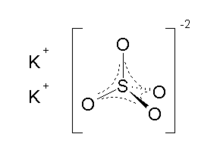Potassium sulfate
 Arcanite
|
|
 |
|
| Names | |
|---|---|
| Other names
Potassium sulphate
|
|
| Identifiers | |
|
7778-80-5 |
|
| 3D model (Jmol) | Interactive image |
| ChEBI |
CHEBI:32036 |
| ChEMBL |
ChEMBL1201793 |
| ChemSpider |
22915 |
| ECHA InfoCard | 100.029.013 |
| E number | E515 (acidity regulators, ...) |
| KEGG |
D01726 |
| PubChem | 24507 |
| RTECS number | TT5900000 |
| UNII |
1K573LC5TV |
|
|
|
|
| Properties | |
| K2SO4 | |
| Molar mass | 174.259 g/mol |
| Appearance | White solid |
| Odor | odorless |
| Density | 2.66 g/cm3 |
| Melting point | 1,069 °C (1,956 °F; 1,342 K) |
| Boiling point | 1,689 °C (3,072 °F; 1,962 K) |
| 111 g/L (20 °C) 120 g/L (25 °C) 240 g/L (100 °C) |
|
| Solubility | slightly soluble in glycerol insoluble in acetone, alcohol, CS2 |
| −67.0·10−6 cm3/mol | |
|
Refractive index (nD)
|
1.495 |
| Structure | |
| orthorhombic | |
| Hazards | |
| Main hazards | Irritant |
| Safety data sheet | External MSDS |
| R-phrases | R22 |
| S-phrases | S36 |
| Flash point | Non-flammable |
| Lethal dose or concentration (LD, LC): | |
|
LD50 (median dose)
|
6600 mg/kg (oral, rat) |
| Related compounds | |
|
Other anions
|
Potassium selenate Potassium tellurate |
|
Other cations
|
Lithium sulfate Sodium sulfate Rubidium sulfate Caesium sulfate |
|
Related compounds
|
Potassium hydrogen sulfate Potassium sulfite Potassium bisulfite Potassium persulfate |
|
Except where otherwise noted, data are given for materials in their standard state (at 25 °C [77 °F], 100 kPa).
|
|
|
|
|
| Infobox references | |
Potassium sulfate (K2SO4) (in British English potassium sulphate, also called sulphate of potash, arcanite, or archaically known as potash of sulfur) is a non-flammable white crystalline salt which is soluble in water. The chemical compound is commonly used in fertilizers, providing both potassium and sulfur.
Potassium sulfate (K2SO4) has been known since early in the 14th century, and it was studied by Glauber, Boyle, and Tachenius. In the 17th century, it was named arcanuni or sal duplicatum, as it was a combination of an acid salt with an alkaline salt. It was also known as vitriolic tartar and Glaser's salt or sal polychrestum Glaseri after the pharmaceutical chemist Christopher Glaser who prepared it and used medicinally.
The mineral form of potassium sulfate, arcanite, is relatively rare. Natural resources of potassium sulfate are minerals abundant in the Stassfurt salt. These are cocrystallizations of potassium sulfate and sulfates of magnesium calcium and sodium.
Relevant minerals are:
The potassium sulfate can be separated from some of these minerals, like kainite, because the corresponding salt is less soluble in water.
Kieserite, MgSO4·H2O, can be combined with a solution of potassium chloride to produce potassium sulfate.
Approximately 1.5 million tons were produced in 1985, typically by the reaction of potassium chloride with sulfuric acid, analogous to the Leblanc process. Potassium sulfate is produced according to the following reaction, which is conducted in so-called Mannheim furnaces:
...
Wikipedia
